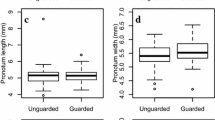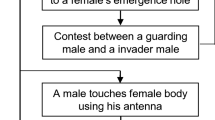Abstract
After copulation, male grasshoppers of Sphenarium purpurascens (Orthoptera: Pyrgomorphidae) remain in a postinsemination association with their mate. A male can spend as many as 17 days mounted on a female. Guarding duration is related to both male and female body size and the female's mating history. Longest guarding durations were recorded at the middle of the reproductive season, when the probability of encounter between the sexes (sex ratio and population density) was decreasing, at the beginning of the associated dry season. These guardings were associated with large individuals of both sexes and with females that had more previous partners. Moreover, a positive association was found among guarding duration, female and male body size and age, and number of copulations performed by the males. Maybe males invest time and sperm in females as a function of the probability of sperm competition. Nevertheless, guarding may provide benefits to both sexes. Males may reduce the possibility of sperm competition, and females may obtain nutritional benefit for themselves or their offspring as a result of multiple copulations. Changes in male investment in guarding duration and number of copulations may be the result of physiological constraints related to seminal and/or sperm production. Moreover, guarding duration could be constrained by ecological factors such as a reduction of food availability associated with the beginning of the dry season.
Similar content being viewed by others
References
Alcock, J. (1994). Postinsemination association between males and females in insects: The mate-guarding hypothesis. Annu. Rev. Entomol. 39: 1-21.
Andersson, M. (1994). Sexual Selection, Princeton University Press, Princeton, NJ.
Aspi, J., and Hoikkala, A. (1995). Male mating success and survival in the field with respect size and courtship song characters in Drosophila littoralis and D. montana. J. Insect Behav. 8: 67-87.
Cordero, C. (1995). Ejaculate substances that affect female insect reproductive physiology and behavior: Honest or arbitrary traits? J. Theor. Biol. 174: 453-461.
Cueva del Castillo, R., and Núñez-Farfán, J. (1999). Sexual selection on maturation time and body size in Sphenarium purpurascens (Orthoptera: Pyrgomorphidae): Correlated response to selection. Evolution 53: 209-215.
Cueva del Castillo, R., and Núñez-Farfán, J. (2002). Female mating success and risk of prereproductive death in a protandrous grasshopper. Oikos 96: 217-224.
Cueva del Castillo, R., Núñez-Farfán, J., and Cano-Santana, Z. (1999). The role of body size in mating success of Sphenarium purpurascens in central Mexico. Ecol. Entomol. 24: 146-155.
Darwin, C. R. (1859). On the Origin of Species by Means of Natural Selection, on the Preservation of Favoured Races in the Struggle for Life, John Murray, London.
Friedel, T., and Gillot, C. (1976). Male accessory gland substance of Melanoplus sanguinipes: An oviposition stimulant under the control of the corpus allatum. J. Insect Physiol. 22: 489-495.
Friedel, T., and Gillot, C. (1977). Contribution of male-produced protein to vitellogenesis in Melanoplus sanguinipens. J. Insect Physiol. 23: 145-151.
Gomendio, M., and Roldan, E. R. S. (1993). Mechanisms of sperm competition: Linking physiology and behavioural ecology. Trends Ecol. Evol. 8: 95-99.
Grafen, A., and Ridley, M. (1983). A model of male guarding. J. Theor. Biol. 102: 549-567.
Honek, A. (1993). Intraspecific variation in body size and fecundity in insects: A general relationship. Oikos 66: 483-492.
Kevan, D. K. McE. (1977). The American Pyrgomorphidae (Orthoptera). Rev. Soc. Entomol. Argentina 36: 3-28.
Mitchell-Olds, T., and Shaw, R. G. (1987). Regression analysis of natural selection: Statistical inference and biological interpretation. Evolution 41: 1149-1161.
Pardo, M. C., Camacho, J. P. M., and Hewitt, G. M. (1994). Dynamics of ejaculate nutrient transfer in Locusta migratoria. Heredity 71: 190-197.
Pardo, M. C., López-León, M. D., Hewitt, G. M., and Camacho, J. P. M. (1995). Female fitness is increased by frequent mating in grasshoppers. Heredity 73: 654-660.
Parker, G. A. (1970). Sperm competition and its evolutionary consequences in insects. Biol. Rev. Cambridge Philos. Soc. 45: 525-567.
Parker, G. A. (1974). Courtship persistence and female guarding as male investment strategies. Behaviour 48: 157-184.
Parker, G. A. (1998). Sperm competition and the evolution of ejaculates: Towards a theory base. In Birkhead, T. R., and Möller, A. P. (Eds.), Sperm Competition and Sexual Selection, Academic Press, London, pp. 3-49.
Reinhardt, K., Kohler, G., and Scumacher, J. (1999). Females of the grasshopper Chorthippus parallelus Zett do not remate for fresh sperm. Proc. R. Soc. Lond. B 266: 2003-2009.
Ridley, M. (1983). The Explanation of the Organic Diversity: The Comparative Method and Adaptations for Mating, Clarendon Press. Oxford.
Simmons, L. W. (1995). Correlates of male quality in the field cricket Gryllus campestris L.: Age, size and symmetry determine pairing success in the field populations. Behav. Ecol. 6: 376-381.
Stoks, R., De Bruyn, L., and Matthysen, E. (1997). The adaptiveness of intense contact mate guarding by males of the emerald damselfly, Lestes sponsa (Odonata, Lestidae): The male's perspective. J. Insect Behav. 10: 289-298.
Thornhill, R., and Alcock, J. (1983). The Evolution of Insect Mating Systems, Harvard University Press, Cambridge, MA.
Wickler, W., and Seibt, U. (1985). Reproductive behaviour in Zonocerus elegans (Orthoptera: Pyrgomorphidae) with special reference to nuptial gift guarding. Z. Tierpsychol. 69: 203-223.
Yamamura, N. (1986). An evolutionarily stable strategy (ESS) model of postcopulatory guarding in insects. Theor. Popul. Biol. 29: 438-455.
Yamamura, N. (1987). A model on correlation between precopulatory guarding and short receptivity to copulation. J. Theor. Biol. 127: 171-180.
Author information
Authors and Affiliations
Corresponding author
Rights and permissions
About this article
Cite this article
Cueva del Castillo, R. Body Size and Multiple Copulations in a Neotropical Grasshopper with an Extraordinary Mate-Guarding Duration. Journal of Insect Behavior 16, 503–522 (2003). https://doi.org/10.1023/A:1027303323242
Issue Date:
DOI: https://doi.org/10.1023/A:1027303323242




